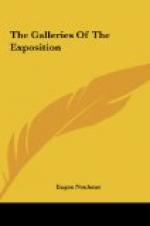There is a big difference between Liljefors and Mrs. Boberg, or again between her and Fjaestad, but not any greater than between all of these artists and John Bauer. John Bauer’s paintings are exquisite, and even such abused adjectives as “sweet” and “delicate” are not out of place when applied to his work. I hope we have some enlightened person among us who can afford to buy the whole batch of them, and do it quickly, before any more of them are sold singly. It takes more time to enjoy these little fairy tales than one can afford to give to them. They possess everything a good illustrative painting ought to have. A wealth of ideas imaginatively represented, good drawing, and intimate feeling tell of the keen pleasure the artist must have had in producing these gems.
As an illustrator, though very different, Carl Larsson appeals in a comprehensive group of pictures in another gallery. Carl Larsson’s extraordinary resourcefulness in getting everything he needs out of the confines of his home has for years been the cause of his great popularity abroad, and in his thirty-three cheerful drawings he discloses his entire home life, in all the variety of happenings which makes married existence a success. His drawing is faultless, his sense of colour supple and refreshing, and his ability to make such extensive use of the relatively narrow atmosphere of his home without exhausting it proves his caliber. Larsson has a roommate of great distinction and modesty in Oscar Bergman, who has contributed some twenty tender bits of northern landscapes and marines. They are reminiscent of the Japanese, although it becomes almost foolish to think of the Japanese every time someone develops a capacity for acute observation and drawing. Bergman’s little lighthouse is particularly convincing and, like most of these things, should not be allowed to return to the artist.
I shall probably have to retrench in attention to the American section if I keep on giving pages to this section. But in spite of their great merit, the work of Kallstenius, Schultzberg, Carlberg, and Osslund will have to go with only meager reference. Osslund’s pictures are somewhat startling at first, owing to a complexity of technical treatment. He does not seem to be working in the right medium, for I believe his Japanesque landscapes could be far more sympathetically presented in watercolour. Of the group comprising his work, his “Waterfall”, “Summer Evening”, and “Evening on Angermann Land” are very fascinating. Mas-Olle’s portraits are interesting not only for good technical painting but also for fine characterization. His portrait of an old peasant of Dalecarlia is almost faultless. Near the Mas-Olle portrait Herman Lindquist has a “Sunny April Day” of unusual poetic claim. Schultzberg’s big sunlit winter scenes hardly need recommendation to justify their increasing popularity. Alfred Bergstrom’s poetic landscapes add more interest, in the small adjoining room on the east. Marine pictures by




